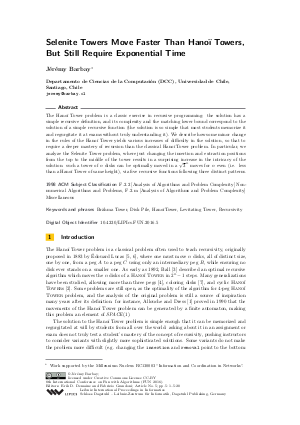Selenite Towers Move Faster Than Hanoï Towers, But Still Require Exponential Time
Author Jérémy Barbay
-
Part of:
Volume:
8th International Conference on Fun with Algorithms (FUN 2016)
Part of: Series: Leibniz International Proceedings in Informatics (LIPIcs)
Part of: Conference: International Conference on Fun with Algorithms (FUN) - License:
 Creative Commons Attribution 3.0 Unported license
Creative Commons Attribution 3.0 Unported license
- Publication Date: 2016-06-02
File

PDF
LIPIcs.FUN.2016.5.pdf
- Filesize: 0.62 MB
- 20 pages
Document Identifiers
Subject Classification
Keywords
- Brähma tower
- Disk Pile
- Hanoi Tower
- Levitating Tower
- Recursivity
Metrics
- Access Statistics
-
Total Accesses (updated on a weekly basis)
0Document
0Metadata
Abstract
The Hanoi Tower problem is a classic exercise in recursive programming: the solution has a simple recursive definition, and its complexity and the matching lower bound correspond to the solution of a simple recursive function (the solution is so simple that most students memorize it and regurgitate it at exams without truly understanding it). We describe how some minor change in the rules of the Hanoi Tower yields various increases of difficulty in the solution, so that to require a deeper mastery of recursion than the classical Hanoi Tower problem. In particular, we analyze the Selenite Tower problem, where just changing the insertion and extraction positions from the top to the middle of the tower results in a surprising increase in the intricacy of the solution: such a tower of n disks can be optimally moved in 3^(n/2) moves for n even (i.e. less than a Hanoi Tower of same height), via 5 recursive functions (or, equivalently, one recursion function with five states following three distinct patterns).
Cite As Get BibTex
Jérémy Barbay. Selenite Towers Move Faster Than Hanoï Towers, But Still Require Exponential Time. In 8th International Conference on Fun with Algorithms (FUN 2016). Leibniz International Proceedings in Informatics (LIPIcs), Volume 49, pp. 5:1-5:20, Schloss Dagstuhl – Leibniz-Zentrum für Informatik (2016)
https://doi.org/10.4230/LIPIcs.FUN.2016.5
BibTex
@InProceedings{barbay:LIPIcs.FUN.2016.5,
author = {Barbay, J\'{e}r\'{e}my},
title = {{Selenite Towers Move Faster Than Hano\"{i} Towers, But Still Require Exponential Time}},
booktitle = {8th International Conference on Fun with Algorithms (FUN 2016)},
pages = {5:1--5:20},
series = {Leibniz International Proceedings in Informatics (LIPIcs)},
ISBN = {978-3-95977-005-7},
ISSN = {1868-8969},
year = {2016},
volume = {49},
editor = {Demaine, Erik D. and Grandoni, Fabrizio},
publisher = {Schloss Dagstuhl -- Leibniz-Zentrum f{\"u}r Informatik},
address = {Dagstuhl, Germany},
URL = {https://drops.dagstuhl.de/entities/document/10.4230/LIPIcs.FUN.2016.5},
URN = {urn:nbn:de:0030-drops-58729},
doi = {10.4230/LIPIcs.FUN.2016.5},
annote = {Keywords: Br\"{a}hma tower, Disk Pile, Hanoi Tower, Levitating Tower, Recursivity}
}
Author Details
References
-
J.-P. Allouche and F. Dress. Tours de Hanoï et automates. RAIRO, Informatique Théorique et applications, 24(1):1-15, 1990.

-
M.D. Atkinson. The cyclic towers of Hanoï. Information Processing Letters (IPL), 13(118-119), 1981.

-
W. R. Ball. Mathematical Recreations and Essays. McMillan, London, 1892.

-
J. S. Frame and B. M. Stewart. Solution of problem no 3918. American Mathematics Monthly (AMM), 48:216-219, 1941.

-
Édouard Lucas. La tour d'Hanoï, véritable casse-tête annamite. In a puzzle game., Amiens, 1883. Jeu rapporté du Tonkin par le professeur N.Claus (De Siam).

-
Édouard Lucas. Récréations Mathématiques, volume II. Gauthers-Villars, Paris, quai des Augustins, 55, 1883.

-
D. Wood. The towers of Brahma and Hanoï revisited. Journal of Recreational Mathematics (JRM), 14(1):17-24, 1981.

